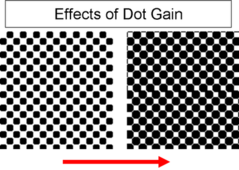
Make it easier for all your minders to match the proof. It doesn’t matter how good your proof accuracy or how skilled your minder is, if you aren’t getting the right colour of solid ink weights and the right amount of dot gain on press it’s all but impossible to match the proof.
Your minder really only has one tool to help them correct jobs not properly prepared for their press, ink film thickness. If there isn’t enough dot in an image they can increase that by putting down more ink, but that’s going to send the solid areas away from the proof, likewise if there’s too much dot they can lighten the inking but the solid areas are going to look horribly light. It’s an impossible balancing game if your dot gain isn’t correct.
Your prepress systems should be calibrated for your press, producing the right amount of dot on plate to produce the same amount of dotgain on press as your target printing process or proof. Get the dot gain right and your minder will be able to run the colour bar to the correct ink weights to achieve the right solid colour and adjust the fit, and all the half tones and images will drop into place and match the proof with minimum adjustment.
Getting your press printing the same as your proof (typically based on ISO 12647-2:2004, such as Fogra39, or ISO12647:2013, such as Fogra 51) is a two part process, firstly running tests on press to establish the correct solid ink weights for your brand of ink and paper to achieve the correct colour in the solids, and then running dot gain calibration charts on press to measure how much dot gain your press has. This data is then taken back to your RIP or workflow system to create calibration curves to adjust the amount of dot that will be produced on press to match the TVI (Tone Value Increase) of the standard you’re trying to match.
Once correctly calibrated not only will you be able to more easily match your proofs on press, but you’ll also be matching the colour output of other printers running to the same standard. Press calibration is an essential part of today’s colour management, without it your ability to match a proof or match your digital presses, is left entirely to chance.
